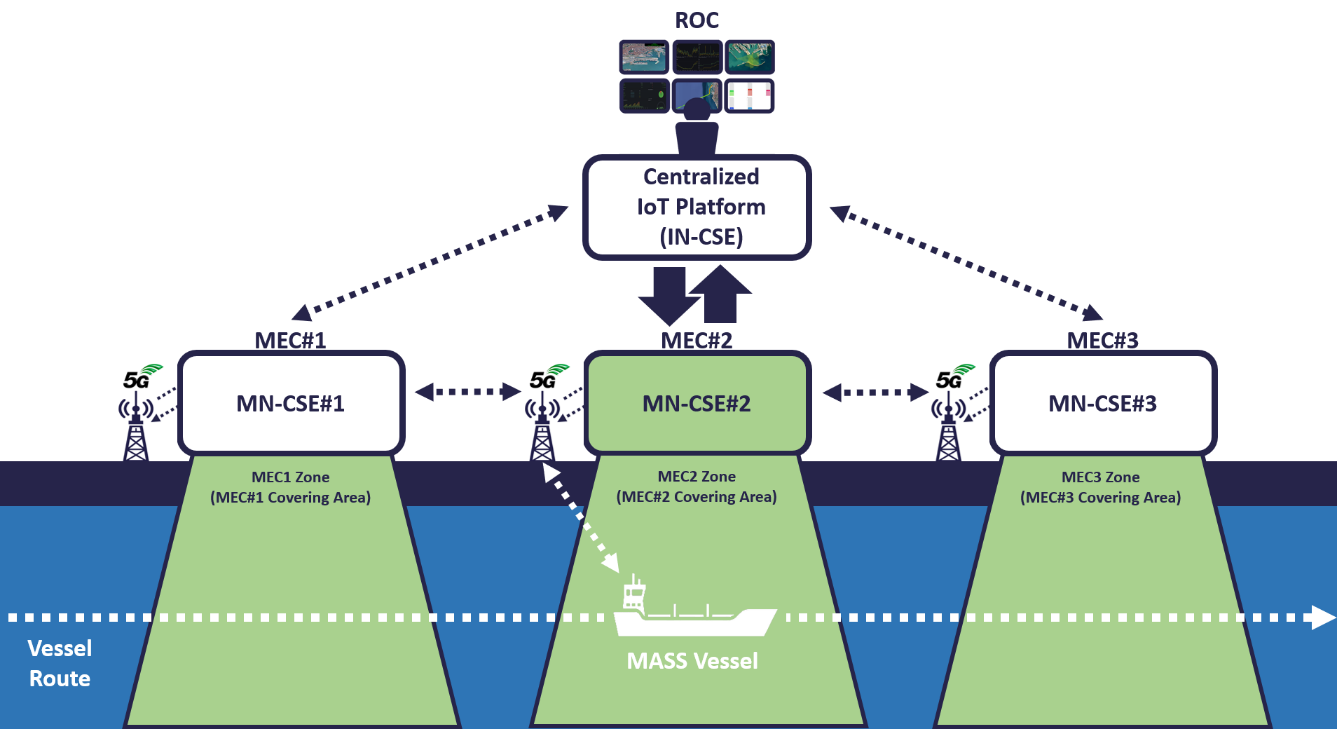
This clause examines the application of ETSI MEC and oneM2M technologies within the maritime domain, with a particular focus on smart ports scenarios. The effective integration of these two standards enables significant advancements in operational efficiency, safety, and interoperability. By combining MEC’s edge computing capabilities with oneM2M’s standardized IoT framework, ports can support low-latency and effective processing across heterogeneous access networks, while ensuring seamless coordination among connected devices from different manufacturers. This lays the groundwork for smarter, more automated, and resilient port infrastructures.
For example, surveillance cameras installed in ports can process video streams in real time using AI algorithms deployed on MEC infrastructure. This allows automatic detection of suspicious activities, intrusions, or hazards, without transferring large volumes of data to the cloud. Similarly, if a container is accessed in a restricted area, security sensors can generate an alert processed directly at the edge, triggering immediate responses like notifying personnel or locking access gates, thereby drastically reducing response times.
In an increasingly interconnected environment, the logistics and supply chain industry faces challenges such as real-time tracking, shipment security, and continuous operations. ETSI MEC and oneM2M provide a powerful framework to address these needs by enabling low-latency communication, reliable data handling, and coordination across diverse devices and networks.
The MEC architecture allows data processing directly at the edge, within port terminals or logistics centers, rather than relying on remote cloud servers. MEC also enables local services to analyze data from distributed IoT sensors and detect anomalies such as unusual vibrations, temperature variations, or structural damage. Acting on this information locally improves reliability and responsiveness.
A crucial strength of MEC lies in its independence from the underlying network technology—whether using 5G, 4G, Wi-Fi, or LoRaWAN, processing continues uninterrupted even during network outages or congestion. Meanwhile, oneM2M ensures interoperability among diverse IoT devices and connectivity standards, providing a scalable and standardized approach to manage high-density IoT deployments.
Distributed monitoring networks for enhanced situational awareness and the automation of logistics operations are examples where the joint application of MEC and oneM2M technologies excels.
In this regard, we propose a scenario focused on Maritime Autonomous Surface Ships (MASS)—commercial vessels that operate with little or no human intervention. These ships rely on integrated automation systems, AI models, and advanced sensors to navigate, make decisions, and perform tasks autonomously. Communication with Remote Operation Centers (ROCs), implemented in cloud-based architectures, enables real-time monitoring and control using data from LIDAR, radars, cameras, IoT sensors, AIS, and more. The link between vessels and ROCs leverages low-latency communication technologies such as 5G NR and beyond.
This scenario proposes a collaborative architecture between a oneM2M-compliant platform and the ETSI MEC edge computing framework, enabling assisted manoeuvring services to unmanned ships in real-time within seaport waters.
In this architecture:
Edge-located MN-CSE instances are deployed as MEC applications on distributed edge nodes to process data when the vessel approaches or departs from its assigned berth. A cloud-based oneM2M IN-CSE instance serves as the central hub, storing and managing vessel data such as position, speed, course, and environmental conditions. When the vessel enters a MEC-covered area, the IN-CSE automatically offloads computational tasks—like the localization of other vessels—to the MN-CSE to guarantee low-latency processing for generating warnings and situational updates. The MN-CSE can immediately analyze incoming data, reducing reliance on distant cloud servers and ensuring responsiveness. As the vessel transits through different MASS zones, tasks seamlessly migrate between edge nodes, guaranteeing service continuity for mission-critical operations including assisted manoeuvring, collision avoidance, and situational awareness.
The MEC platform, hosted on physical edge nodes (gNodeB), runs the MN-CSE as a MEC application. It manages dynamic deployment and migration of MN-CSE instances based on vessel mobility and interacts with the IN-CSE for offloading decisions. This combination allows real-time decision-making and continuous support for mission-critical services while vessels move through multiple MEC zones.
Enabling standardized IoT deployments in MEC environments for advanced maritime systems.
The founding members of this effort are CNIT, UNIMORE, xFlow, JK Consulting and Projects, FSCOM, Sejong University, Digital SME, Deutsche Telekom AG, Exacta GSS, Networks SRL, and Telecom Italia S.p.A. To register or learn more, contact estimed@etsi.org or visit https://estimed.etsi.org.
About ETSI
ETSI provides members with an open and inclusive environment to support the development, ratification, and testing of globally applicable standards for ICT systems and services across all sectors of industry and society. We are a non-profit body with more than 950 member organizations worldwide, drawn from 64 countries and five continents. Our members include large and small private companies, research entities, academia, government, and public organizations. ETSI is officially recognized by the EU as a European Standardization Organization (ESO). For more information, visit https://www.etsi.org.
Author:
CNIT


